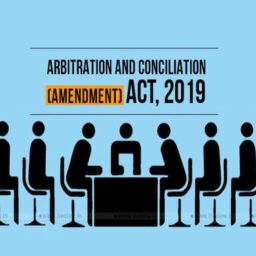INTRODUCTION
The most accepted and undoubted fact about India is that its diverse population has led to various disputes and conflicts. Our judiciary is going to the dockets of cases. But every problem brings a solution with too, this dynamic problem evolved one of the Alternative Dispute Resolution methods i.e., mediation as a solution.
What is Mediation?
As defined in Black’s Law Dictionary, Alternative Dispute Resolution is a method of dispute resolution involving one or more third parties for settling the disputes by means other than litigation, such as arbitration or mediation.[1] However, the more convenient, cost-efficient, and confidential is the resolution method of Mediation. Basically, Mediation consists of three parties, the two parties to a dispute and another is a mediator, it is the process of talking to two separate people or groups involved in a disagreement to try to help them to agree or find a solution to their problems. The mediator act as an intermediary to bring the parties to dispute to an understanding while the decision-making power remains with parties. The third-party has to act neutrally to maintain the process party-centric.
Mediation in India is of the following types:
- Court referred Mediation
- Private Mediation
In court-referred mediation, the court may under section 89 of the Code of Civil Procedure (1908), refer pending cases for mediation while in Private Mediation any layman can appoint a mediator to resolve their disputes.
Recent related news
- Still, there is The United Nations Convention[2], on International Settlement Agreement but in 2019 but it hasn’t been ratified as law. But recently, the Union law Minister of India stated that “In the upcoming winter session of the parliament, we will table a bill on mediation. Preparations for the same have been complete” Kiren Rijiju stated[3]
He also added, “we want to make India a hub of international arbitration”.
Perks of Mediation over Litigation
The primary advantage of meditation in India is the privacy of whole dispute resolution. As the process of mediation consists of parties to dispute and the mediator as a third party makes it a personal and private process. The mediator acts as an impartial third party to facilitate the communication between the parties to disputes which cannot be disclosed in civil proceedings or any other place without the prior consent of parties. The mediator does not impose his decision and only manages the interaction to arrive at an amicable solution.
The control of making decisions after statements from both sides vest with parties helping them to reach a mutual solution. On the other hand, in litigation, the control of decision-making remains with the jury. However, Mediation gives autonomy to the parties over the scope of mediation and its outcomes. Consequently, the process helps parties to satisfy their interests, examine options and grab a deal beneficial to all.
The Mediation is conducted according to the convenience of parties but in litigation, the issue of jurisdiction makes it less convenient to parties. Also, as mediation is used in the early stage of disputes, the solution can be reached quickly as compared to litigation. Ultimately, mediation preserves the relationship whether it may be a family dispute or business relationship, it helps to communicate assertively rather than keeping a chip on shoulders.
Ancient Mediation in India
The non-adversarial dispute resolution processes are not new to Indian society, the tribunal called KULA was set by scholar Yajnavalkya, the system dealt with dispute resolution between communities, members of family, tribes, etc. There was extraordinary growth of trade and commerce during the time of Yajnavalkya which led to the development of tribunals like SHRENI and PUGA. Cases were decided on the proportionate basis of customs and usage with justice, equity, and good conscience.
Another scholar Parashar suggested that some issues of dispute should be decided by the assembly or Parishad of learned people. The modern mechanism of legislation for resolving disputes related to matrimonial disputes or commercial institutions and merchant associations find their roots back in customary law in India.
Buddha said “Meditation brings wisdom, lack of meditation leaves ignorance. Know well what leads you forward and what holds you back; choose that which leads to wisdom”. As society evolved the informal decision-making institutions became more structured and gave rise to the judicial system but the principle of mediation has not lost its relevance in the modern world. Rather the world is in dire need to pave a way forward with a dispute resolution system like mediation that could keep peace and harmony in society.
Current Jurisprudence on Mediation in India
There are various legislations on ADR which contains a wide range of mechanisms where the parties can refer resolve their issues without litigation. For example, under section 89 of the Code of Civil Procedure[4], the court can formulate the terms of settlement and refer them to arbitration, conciliation, mediation, judicial settlement, or Lok Adalat. There is a uniform statute for Arbitration and conciliation enacted in 1996. A Lok Adalat is set up under the Legal Services Authority Act, 1987[5]. But in there is no stand-alone legislation for mediation in India due to which the difference between conciliation and mediation became ambiguous. So, the terms were listed separately under section 89 of the Code of Civil Procedure (Amendment) Bill, 1997 which implies that they are different processes. But the 163rd report of the Law Commission of India rejected the idea of the bill. Even then the parliament enacted section 89 with original lines.
However, there are laws that advocate compulsory mediation before filing a suit in court some of which are as follows:
- The Industrial Disputes Act,1947[6](section 4)
- The Companies Act, 2013[7](Section 4)
- The Micro, Small and Medium Enterprises Development Act, 2016[8]
- The Real Estate (Regulation and Development) Act, 2016[9]
- The Consumer Protection act, 2019[10]
But still, there is a need for stand-alone law because there are confusions in interpretations of mediation as in Para 2.7 of report no. 238 of The Law Commission of India[11], it was stated: “there is practically no difference between conciliation and mediation and quite often used as interchangeable terms”. However, the terms are not identical to be used interchangeably as the definition is different in Singapore convention for each.
Analysis
The jurisprudence mentioned above is introduced in India but along with it, we need quick development of mediation mechanism. There is a need for a Uniform statute for governing the mediation process in India. India being a signatory to Singapore Convention which aims to harmonize the legal framework to invoke the settlements. The Singapore convention renewed demand for a statutory law on mediation. Also, the Supreme Court of India had set up a committee to prepare a draft for recommendation to the government. “SIAC-SIMC Arb-Med-Arb Protocol” has been formulated by the Singapore International Arbitration Centre (SIAC) and the Singapore International Mediation Centre (SIMC) for commercial contracts. However, in India, the mediation mechanism lacks somewhere because people prefer litigation over any other method of revolution but there might be situations where mediation may be more effective and appropriate. To identify these situations and cases formal training of mediation along with pragmatic recognition by the legislature and the judiciary. Theoretical along with practical training should be introduced in college courses and vocational sessions should be conducted for practicing lawyers. Also, Multi-Mediation drives can prove effective at various levels to clear the backlog of cases.
Conclusion
We do not have to go through lots of wrong roads to find the right one. The Supreme Court has set up a committee of preparing draft legislation to give legal paramountcy to dispute resolution methods of mediation. It is a progressive initiative to evolve the ADR mechanism. By making a new law we will have an elusive novice law for mediation which will address the issues identified for mediation.
Author(s) Name: Yashaswani Parashar (University of Petroleum and Energy Studies, Dehradun)
References:
[1] Black’s Law Dictionary (2015, 8th edition)
[2] United Nations Convention on International Settlement Agreements Resulting from Mediation (Adopted 20 December 2018) UN (the Singapore convention on Mediation)
[3] Aaratrika Bhaumik, ‘Centre will introduce new law on mediation in upcoming winter session of parliament’ (Live Law, 11 September 2021) <Centre Will Introduce New Law On Mediation : Law Minister Kiren Rijiju (livelaw.in)> accessed 24 September 2021
[4] The Code of Civil Procedure 1908.
[5] The Legal Services Authority Act 1987.
[6] The Industrial Disputes Act 1947.
[7] The Companies Act 2013.
[8] The Micro, Small and Medium Enterprises Development Act 2016.
[9] The Real Estate (Regulation and Development Act 2016.
[10] The Consumer Protection Act 2019.
[11] Law Commission, Amendment of Section 89 of the Code of Civil Procedure,1908 and allied provisions (Law com No. 238,2011) para 2.7.









